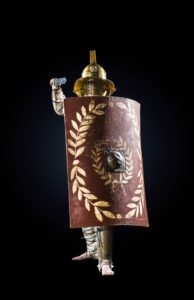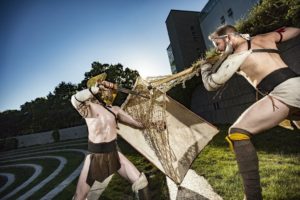Servi Morituri – Death and Glory
Show fight project Servi Morituri was founded in 2016 for Espoo City Museum’s in their “Gladiaattorit – Kuolema ja Voitto” exhibition (lit. Gladiators – Death and Victory). The project brought together an experienced dream-team that still serves as the base for the Hirdmenn group. We merely adopted a new name in support for the new context for the fight show. The preparations for the gladiator exhibition took one year, using the same principles as with the upcoming Hirdmenn show. This included producing and sourcing suitable replicas of the weapons and armor, studying and training of the period training methodology, and familiarizing with the ancient pictorial sources.
The equipment was used according to their closest documented counterpart, or according to general principles which were familiar for the performers. For example, the scutum was used in the way any large shield would have been used with the addition of the positions shown in roman mosaics, whereas the trident was used in the ways shown by Joachim Meÿer in his Gründtliche Beschreibung der Kunst des Fechtens for a staff or a short halberd with addition of chosen pollaxe techniques from the anonymous Le Jeu de la Hache (MS Francais 1996) and Fiore de’i Liberi’s Fior di Battaglia (MS M.383). The museum staff filmed an Art of Craftsmanship – type of documentary for the beginnings of the preparatory work the fight show with a successful viral social media campaign https://www.youtube.com/watch?v=5Avzs0AFaGU .
One of the most useful sources was unsurprisingly De Sanitate Tuenda by Galen of Pergamon. Galen worked as an archiereus (a priest/doctor) of a gladiator school in Pergamon during 160-161 A.D. where he studied the wounds patterns and training methods of the

gladiators, and wrote down 32 different ways that the gladiators trained. Not only did he operate successfully on seriously injured gladiators, but the reason why his writings were well known throughout the history was that later on he became the personal doctor of emperor Commodus.
Slightly later, in year 220 the Greek philosopher Lucius Flavius Philostratus described in his Gymnasticus how the Greek athletes prepared themselves for competitions using four-day training cycles. Another source for gladiatorial training was Epitoma rei Militaris by Publius Flavius Vegetius Renatus in the 400s. On top of these texts, there are scattered short descriptions of gladiatorial fights mostly recorded by the members of the audience, discussing the tactics, fighting styles and equipment of different gladiators. The pictorial evidence provided by Roman mosaics and murals show us how did the gladiators look like. Finally, the probable cause of death findings from 67 gladiator skeletons, dated to year 2 A.D. in a graveyard in Ephesus show that the fights were violent but governed by a set of rules.
The 30 minute fight exhibition containing three gladiator fights was choreographed entirely based on the above findings. The exhibition was was well received by the audiences and critics alike, and was acclaimed by classical historians, the museum staff and news media, including the national broadcast company YLE and the country’s largest newspaper Helsingin Sanomat: “Everything shows that the gladiators of Servi Morituri group have prepared meticulously for their task” — HS
http://www.hs.fi/kaupunki/a1454212004821?jako=e6cc1839e39678bcf27d25d89b82cfa8
With this in mind it was a disappointment that the concept proved to be difficult to sell for booking agencies afterwards. Even though the planned reprise for the show is an unfulfilled dream at this point, the project is stored for safekeeping with existing marketing material, well documented choreographies and the weapons and armor maintained in the inventory.
The show was designed with a riveting structure. The part of the manager for the gladiators’ ludus was played by a real-life circus artist Juho Sarno, who opened up the show by letting the audience oil up the gladiators as they were warming up. It was noted that this opportunity was eagerly picked up by mature audience, mostly women. After every fight the audience was invited to decide the fate of the lost fighter, and at the end of the show the fighters left alive got to show their gear to the members of the audience who wanted to try them out or to just present question s to the gladiators.
s to the gladiators.
There is still room for improvement. The dramaturgy of the short intervals between the fights were left pretty rough, which prompted for a rework with a director for a reprise. Two directors, Juho Sarno and Sami Vartiainen stated being available for it, but no funding has been found for the project. Technique wise, the fighting net of retiarius was found to be difficult to use and it was left for lesser practice. The principles for its use were new to the group, and use of such weapons are not well documented. Even though the little amount it was used, managed to be impressive and convincing at the same time, this weapon would benefit from further research.
The Hirdmenn project is able to learn from the experiences gained along the years. The upcoming production has been able to navigate through these difficulties, and all the weapons used are thoroughly familiar to the performers. The dramaturgy is built in a way that supports the fight performances in context that truthfully depicts the nature of the combat. There will also be even more fights and they will convey even more dangerous and ferocious feeling to the audience. There’s no doubt that the Hirdmenn show will be even better than the Gladiators.